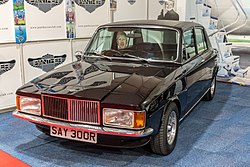Panther Rio
| Panther | |
|---|---|
|
Panther Rio
|
|
| Rio | |
| Production period: | 1975-1977 |
| Class : | Middle class |
| Body versions : | limousine |
| Engines: |
Gasoline engines : 1.8–2.0 liters |
| Length: | 4115 mm |
| Width: | 1575 mm |
| Height: | 1372 mm |
| Wheelbase : | 2438 mm |
| Empty weight : | |
The Panther Rio is a compact British luxury sedan based on the Triumph Dolomite , manufactured by Panther Westwinds in 1975 and 1976 .
The concept: a boutique car
Panther Westwinds had become known for its replica models since the early 1970s . In particular, the Panther J72 , which was a relatively accurate copy of a Jaguar SS 100 , was well received by the market and the press. Inspired by these successes, Panther diversified its production in the mid-1970s, both - with the Panther Lima - in lower-priced market segments as well as in the upper class; the latter area was to be served by the Panther De Ville presented in 1974 , a free reinterpretation of the Bugatti T 41 "Royale" . As a result of the oil crisis , the market for large, high-consumption luxury vehicles collapsed from 1973 onwards. As an alternative, Panther founder Robert Jankel developed the idea of a compact luxury vehicle in which the price was justified not by the size, but by the high-quality equipment. However, Panther could not afford a completely new development. So Robert Jankel ultimately decided on the concept of so-called boutique cars , in which a mass-produced vehicle was alienated by more or less far-reaching modifications to the body while retaining the essential design features and superstructures and upgraded with an exclusive interior. This concept was ultimately an adaptation of traditional coachbuilding to the circumstances of the modern age, in which self-supporting bodies and strict safety regulations made individual superstructures for luxury vehicles considerably more difficult, if not impossible. Boutique cars had their origins in the USA , where vehicles from the El Morocco (a Chevrolet with Cadillac- style body extensions) to the Corvorado von Les Dunham (a Chevrolet Corvette with Cadillac Eldorado trains) up to 1971 again had their origin resurrected Stutz had established a corresponding tradition. In Europe, Panther Westwinds was one of the first companies to follow this concept; with only a slight delay, Monteverdi also produced boutique vehicles with the Sierra (1976) or Felber with various designs.
The car in detail
With the Panther Rio pursued Robert Jankel own words to provide a car for customers on their feet, which is the style of a claim to Rolls-Royce studied in a more economical environment and not in a vulgar from Jankels view Mercedes-Benz environmentally ( or wanted to descend. For his small luxury sedan, Robert Jankel turned to the Triumph Dolomite, a mass-produced compact four-door notchback sedan with rear-wheel drive from the British Leyland Group. The vehicle offered itself because it was available with a sporty engine and, not least because it was based on a design from the early 1960s, enabled the driver to sit comfortably and upright.
Panther left the technology of the Dolomite untouched. The passenger cell, including the glass surfaces, also remained largely unchanged; only the roof line and the shape of the rear doors have been changed slightly. The body below the belt, however, was completely redesigned. The sheets were made by hand from aluminum and had angular lines that should give a classic impression. This was also the purpose of a temple-like radiator grille that rested between two rectangular headlights (from the Ford Granada ). At the rear, Panther installed the tail lights of the Triumph TR6 , which were also used on some Monteverdi models at the same time. The roof was covered with black vinyl as standard. The newly built seats (not taken over from Triumph) were covered with Connolly leather as standard, there were also thick wool carpets and a walnut paneling of the dashboard.
The Panther Rio was offered in two versions: As the basic model with a 1.85 liter four-cylinder and as the Rio Especial with the 2.0 liter 16-valve engine of the Triumph Dolomite Sprint.
The dissemination
The Rio Panther was presented to the public in September 1975. The retail price was £ 9,445 for a Rio Especial . This was a little below the price that was asked for a Bristol 411 . The Triumph Dolomite Sprint on which the Rio was based was £ 3,283 and a Jaguar XJ V12 was available for £ 7,496.
When the Panther Rio was presented, negotiations took place with the London car dealer HR Owen, who was considering ordering around 100 copies of the Rio. In the end nothing came of that; The main reason for this was the very high price, which made selling 100 cars seem like an illusion.
In total, no more than 38 Panther Rio were produced during 1976. One of the vehicles was in Germany at the beginning of the 21st century.
literature
- David Culshaw, Peter Horrobin: The Complete Catalog of British Cars 1895-1975 . Veloce Publishing PLC, Dorchester 1997, ISBN 1-874105-93-6
- Harald Linz, Halwart Schrader: The great automobile encyclopedia , Munich / Vienna / Zurich 1985, ISBN 3-405-12974-5 .


